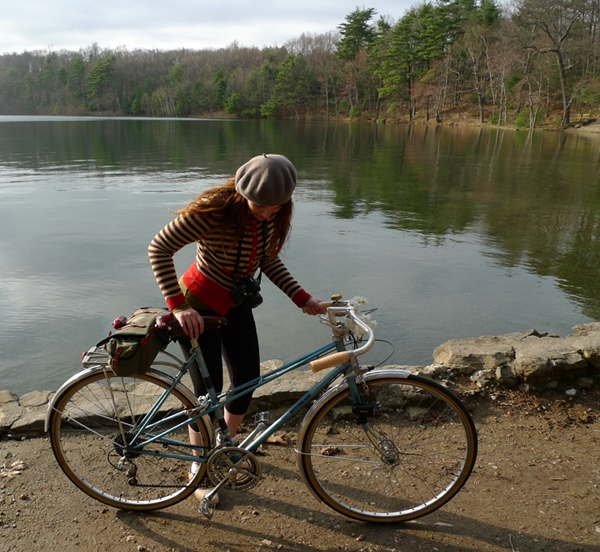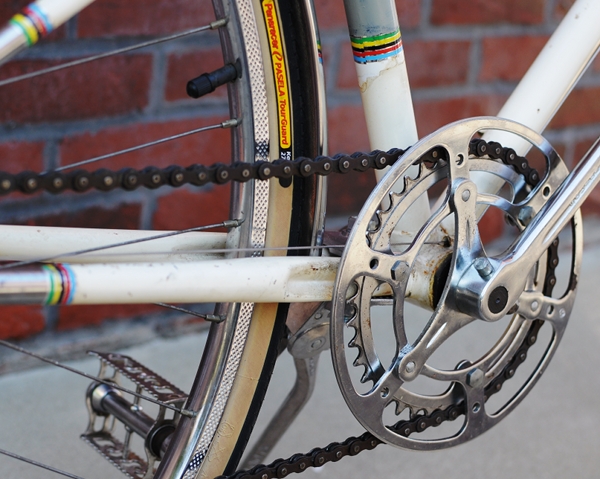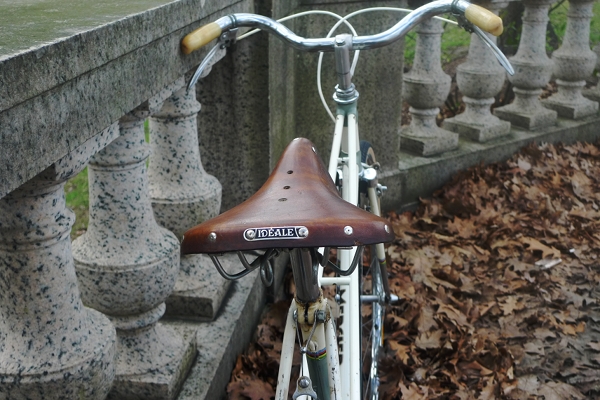 I know that several of my readers are hunting for vintage mixtes at the moment - intending to use them as sportier alternatives to their main transport bikes. Early summer is a good time to buy a vintage mixte, as many are on the market. But before getting swept up in the romance of those twin lateral stays and buying the first attractive mixte you see, it could be helpful to know what to look for - lest you end up with a bicycle that is un-ridable at your skill level, or with a bicycle where you will have to replace so many parts that the purchase will not be worth it.
I know that several of my readers are hunting for vintage mixtes at the moment - intending to use them as sportier alternatives to their main transport bikes. Early summer is a good time to buy a vintage mixte, as many are on the market. But before getting swept up in the romance of those twin lateral stays and buying the first attractive mixte you see, it could be helpful to know what to look for - lest you end up with a bicycle that is un-ridable at your skill level, or with a bicycle where you will have to replace so many parts that the purchase will not be worth it. Let's start with geometry, and I will try not to make this too technical. It is tempting to look at a mixte and think of it as a cute, comfy "girly bike." But most mixtes from the 1970s and 1980s that you will find on the vintage market were designed as roadbikes. This means that they are not that comfy, and not that easy to ride. And this has nothing to do with whether the bike has drop bars vs swept-back handlebars, but rather with the bicycle's inherent geometry. Without measuring distances and angles, here are some ways to test whether a mixte was designed as a roadbike:
Let's start with geometry, and I will try not to make this too technical. It is tempting to look at a mixte and think of it as a cute, comfy "girly bike." But most mixtes from the 1970s and 1980s that you will find on the vintage market were designed as roadbikes. This means that they are not that comfy, and not that easy to ride. And this has nothing to do with whether the bike has drop bars vs swept-back handlebars, but rather with the bicycle's inherent geometry. Without measuring distances and angles, here are some ways to test whether a mixte was designed as a roadbike: 1. Steep Angles? Set the bicycle's saddle height to a level where your leg is extended fully or nearly fully on the downstroke. Are you at all able to touch the ground with one tip of a toe at this saddle height? If yes, or almost, then the bicycle was likely designed with comfortable angles. If not even close, then it was designed with steeper angles. While you can change the angle of the seat tube by moving the saddle backwards, a steep seat tube angle usually means that the bicycle is aggressive in other ways as well, which is what makes it an easy indicator of comfort. Steep angles tend to make a bicycle less comfortable - so take this into consideration.
1. Steep Angles? Set the bicycle's saddle height to a level where your leg is extended fully or nearly fully on the downstroke. Are you at all able to touch the ground with one tip of a toe at this saddle height? If yes, or almost, then the bicycle was likely designed with comfortable angles. If not even close, then it was designed with steeper angles. While you can change the angle of the seat tube by moving the saddle backwards, a steep seat tube angle usually means that the bicycle is aggressive in other ways as well, which is what makes it an easy indicator of comfort. Steep angles tend to make a bicycle less comfortable - so take this into consideration.  2. Toe Overlap? Get on the bicycle and start slowly riding it. Now, turn the handlebars dramatically, either to the left or to the right. Does your toe hit the front wheel at all when you do this? If yes, this is called "toe overlap". Most small-sized road and track bikes have it. For road and track cyclists it is not a problem, as they typically cycle so fast that they do not turn the handlebars. However, a city bike will ideally not have toe overlap - as having your toe hit the front wheel can cause a crash. If you are an inexperienced cyclist and the mixte you are trying has toe overlap, think about whether you are prepared to deal with this before you buy the bike. This aspect of the bike's geometry cannot be altered.
2. Toe Overlap? Get on the bicycle and start slowly riding it. Now, turn the handlebars dramatically, either to the left or to the right. Does your toe hit the front wheel at all when you do this? If yes, this is called "toe overlap". Most small-sized road and track bikes have it. For road and track cyclists it is not a problem, as they typically cycle so fast that they do not turn the handlebars. However, a city bike will ideally not have toe overlap - as having your toe hit the front wheel can cause a crash. If you are an inexperienced cyclist and the mixte you are trying has toe overlap, think about whether you are prepared to deal with this before you buy the bike. This aspect of the bike's geometry cannot be altered. 3. Responsiveness/Squirrelliness? Start riding the bicycle again and pick up some speed; then make some gentle turns. Cycle around the block, where you have to turn the corner several times. Do you feel stable and in control when cornering, or do you feel as if the bicycle turns too sharply and faster than you expected? If the bicycle feels overly-responsive ("squirrelly") on turns, it was likely designed as a roadbike. For an experienced roadie, this is a good thing. For someone transitioning from a stable city bike, this can be scary and not fun at all. This aspect of the bike's geometry cannot really be changed either.
3. Responsiveness/Squirrelliness? Start riding the bicycle again and pick up some speed; then make some gentle turns. Cycle around the block, where you have to turn the corner several times. Do you feel stable and in control when cornering, or do you feel as if the bicycle turns too sharply and faster than you expected? If the bicycle feels overly-responsive ("squirrelly") on turns, it was likely designed as a roadbike. For an experienced roadie, this is a good thing. For someone transitioning from a stable city bike, this can be scary and not fun at all. This aspect of the bike's geometry cannot really be changed either.Once you find a mixte that seems comfortable, take a look at the bike's components and make some mental calculations about value. The main things to consider are the wheels and handlebars.
 Older and lower-end mixte models will typically have wheels with steel rims, unless the previous owner replaced them. You can identify steel rims by their little pockmark-like indentations (click image above to enlarge). These are not good for braking, especially in the rain. On a vintage 3-speed steel rims are not so bad, as you are not cycling very fast anyway. But on a sporty mixte, poor braking power is not a good feature to have. I suggest choosing a mixte with alloy rims, or if there is something special about a steel-rimmed mixte that makes you want that specific bike, factor in the cost of replacing the wheels.
Older and lower-end mixte models will typically have wheels with steel rims, unless the previous owner replaced them. You can identify steel rims by their little pockmark-like indentations (click image above to enlarge). These are not good for braking, especially in the rain. On a vintage 3-speed steel rims are not so bad, as you are not cycling very fast anyway. But on a sporty mixte, poor braking power is not a good feature to have. I suggest choosing a mixte with alloy rims, or if there is something special about a steel-rimmed mixte that makes you want that specific bike, factor in the cost of replacing the wheels. If the mixte you are considering is fitted with drop bars, and you are planning to replace them with swept-back bars, be aware that you will most likely also have to change the stem for reasons of compatibility. Together, a new stem and handlebars can be a costly upgrade. A mixte that already comes with swept-back bars could be a better deal.
If the mixte you are considering is fitted with drop bars, and you are planning to replace them with swept-back bars, be aware that you will most likely also have to change the stem for reasons of compatibility. Together, a new stem and handlebars can be a costly upgrade. A mixte that already comes with swept-back bars could be a better deal. There are, of course, also other important things to consider - like the state of the brakes, derailleur system, headset, hubs, etc. - not to mention whether the frame itself is structurally sound. For this, you will either have to bring a friend who is knowledgeable about bicycle repair, or trust the seller. You will also have to spend extra money on adding fenders, a rack and new tires for the bike. But these issues are common to all vintage bike purchases, so I will not go into them here.
There are, of course, also other important things to consider - like the state of the brakes, derailleur system, headset, hubs, etc. - not to mention whether the frame itself is structurally sound. For this, you will either have to bring a friend who is knowledgeable about bicycle repair, or trust the seller. You will also have to spend extra money on adding fenders, a rack and new tires for the bike. But these issues are common to all vintage bike purchases, so I will not go into them here. What I wanted really was to give a sense of what to expect from a vintage mixte in terms of ride quality, and how to tell whether the basic geometry and set-up of a particular mixte is within your comfort zone. Hope this helps, and happy mixte hunting!
What I wanted really was to give a sense of what to expect from a vintage mixte in terms of ride quality, and how to tell whether the basic geometry and set-up of a particular mixte is within your comfort zone. Hope this helps, and happy mixte hunting!







0 comments:
Post a Comment